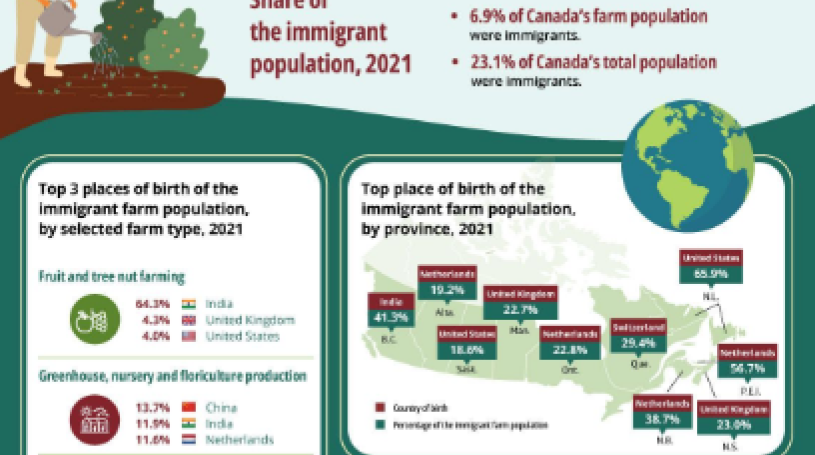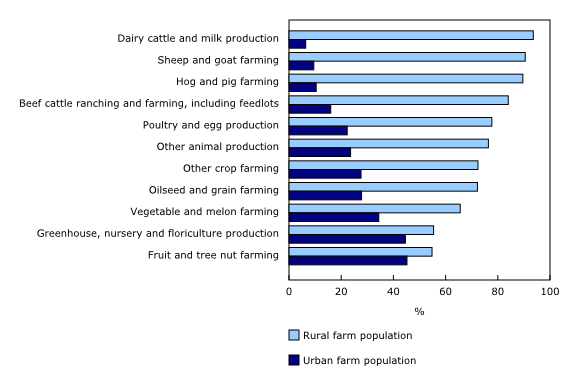The socioeconomic snapshot of Canada's evolving farm population, 2021
Released: 2023-08-25
This article uses information from the "Agriculture–Population Linkage" (this linkage combines data from the Census of Agriculture with the Census of Population) to provide a socioeconomic profile of Canada's farm population. Canada's farm population comprises farm operators (people responsible for the management decisions in operating a farm) and the individuals in their households. In 2021, the farm population (590,710 people) represented 1.6% of the total population in Canada.
Results from the "Agriculture–Population Linkage" show that the face of Canada's farm population is changing. Farm households are becoming more diverse and becoming smaller. Additionally, greater percentages of farm households are living in urban areas, while their income continues to outpace that of the total population.
The immigrant farm population plays a role in shaping Canadian agriculture
Immigrants contribute to the ethnocultural diversity of the farm population. This is important because a diversified farm population provides a broad range of skills, experiences, perspectives and cultural influences that can boost the potential for increased productivity within the agricultural sector.
In 2021, immigrants made up 6.9% of Canada's total farm population, up slightly from 6.8% in 2001. By comparison, the proportion of immigrants in Canada's total population increased from 18.7% in 2001 to 23.1% in 2021.
Under 4% of people in the farm population are part of a racialized group
In 2021, individuals from racialized groups accounted for 3.7% of the total farm population in Canada. Meanwhile, individuals from racialized groups made up more than one-quarter (26.6%) of Canada's total population.
Among the 21,910 people in the farm population who self-identified as being from a racialized group, over half (53.0%) were South Asian, followed by Chinese (15.8%). Black (5.9%) and Latin American (5.9%) were tied as the third-largest racialized group.
The percentage of the Indigenous farm population is increasing
In 2021, 2.8% (16,705 people) of the farm population self-identified as Indigenous. This was slightly higher than the percentage reported in 2001 (2.3%). Meanwhile, 4.8% of Canada's total population self-identified as Indigenous in 2021.
Métis (11,225) remained the largest group among the Indigenous farm population in 2021, accounting for over two-thirds (67.2%) of the total. The second-highest group was First Nations people (4,825), who made up 28.9% of the Indigenous farm population in 2021.
The farm population has a higher percentage of men and older people than the total population
In 2021, over half (52.5%) of the farm population were men, whereas just under half (49.4%) of the total population were men.
The farm population also has a higher percentage of older people. In 2021, over 4 in 10 men (40.3%) in the farm population were 55 years and over, compared with 31.2% in the total population. Meanwhile, 41.0% of women in the farm population were 55 years and over, compared with 33.5% for the total population.
Conversely, the farm population had smaller proportions of men and women under 35 years when compared with the total population. In 2021, 38.2% of men in the farm population were under 35 years, compared with 42.8% for the total population. Meanwhile, 34.4% of women in the farm population were under 35 years, compared with 40.1% for the total population.
The farm population is more likely to report a religious affiliation than the total population
In 2021, nearly three-quarters (72.5%) of the farm population reported a religious affiliation, whereas 65.4% of the total population reported a religious affiliation.
Among the farm population that reported religious affiliations, the most frequently reported religion in 2021 was Catholic (39.3%), followed by Christian, n.o.s. (not otherwise specified) (14.6%) and the United Church (13.8%) (Table 1). This differs from the total population, where Catholic (45.8%), Christian, n.o.s. (11.6%) and Muslim (7.5%) were the three most frequently reported religions among those who reported religious affiliations.
Farm population and farm household trends reflect decreasing farm numbers
Farms have become increasingly sophisticated operations that harmonize automation and modernization advancements. This has corresponded with declines in the number of farms and the farm population in Canada. In 1971, 1 in 14 Canadians was a member of the farm population. By 2021, that number decreased to 1 in 61 Canadians (Table 2). Overall, from 1971 to 2021, the farm population declined by 62.2% to 590,710 people.
The decrease in the size of households in Canada is a widespread societal trend, and farm households are no exception. In 1971, the average size of a farm household was 4.3 people. By 2021, it decreased to 2.8 people. By comparison, the average household size of the total population in 1971 was 3.5 people. By 2021, it fell to 2.4 people.
Median farm household income is higher than the total population
Total income of a farm household includes income from all of its members, regardless of whether their income sources are related to farming or not.
In 1970, the median income of farm households was $36,511 (in constant 2020 dollars). This was 34.0% lower than the median income of households within the total population.
In the past two census periods, the median income for farm households has been higher than that of households within the total population. In 2015, the median income of farm households was $89,230, 17.3% higher than the median household income of $76,048 in the total population. By 2020, the median income of farm households was $95,142, 14.6% higher than the median household income of $83,000 in the total population.
The diversification of income sources within the farm population has evolved over time
In 1970, within the farm population, the average annual self-employed person's non-farm income was $845 (in 2020 constant dollars). By 2020, it had increased 71.4% to $1,448. This increase in non-farm income suggests that the farm is not the sole contributor to farm household income.
Against the backdrop of the COVID-19 pandemic, the proportion of farm households reporting other sources of income as their major source of income increased from 23.7% in 2015 to 29.0% in 2020. This percentage increase may have been impacted by other income from government sources, such as federal government emergency benefits received during the pandemic, which is included as other sources of income.
Private retirement income is also a component of other sources of income that increased. In 2020, private retirement income made up 7.4% of farm household income, up from 6.0% in 2015. This reflects an aging farm population where more members of the farm household are reaching retirement age.
As was also the case in 2015, wages, salaries and commissions were the most frequently reported major source of farm household income in 2020, with 45.9% of farm households reporting this as their major source of income. However, this was lower than what was reported in 2015 (48.9%) (Chart 1).
Chart 1 
Proportion of farm households by major source of household income, Canada, 2015 and 2020
A greater percentage of the farm population is living in urban areas
More of the total population is living in urban areas, and the same is true for the farm population. In 1971, 7.5% of the farm population resided in urban areas. By 2021, that figure grew to nearly one-quarter (24.5%), up from 16.1% in 2016.
The proportion of the farm population living in urban areas differs widely by province, with the highest proportion reported in Newfoundland and Labrador (42.2%), followed by British Columbia (37.8%) and Alberta (28.3%) (Table 3).
In 2021, just over 4 in 10 people (40.8%) in the farm population connected to farm operators working on fruit and tree nut farms and vegetable and melon farms resided in urban areas. These two farm types are more likely to engage in direct marketing activities as a source of income.
The farms primarily situated in rural areas have a demand for large areas of agricultural land for growing field crops and grazing livestock. In 2021, almost three-quarters (72.2%) of the farm population that comprises farm operators working on oilseed and grain farms lived in rural areas.
In 2021, the vast majority (93.6%) of farms classified as dairy cattle and milk were reported in rural areas. On average, these farms reported the third-largest acreage in Canada compared with other types of farms. Dairy cattle and milk farms require frequent supervision and intervention (e.g., milking twice per day), implying that farm operators, and consequently their household members, would likely live close to the farm (Chart 2).
Chart 2 
Rural and urban farm population distribution by farm type in Canada, 2021
Table 1
Farm population reporting religious affiliations by religion, Canada, 2021



